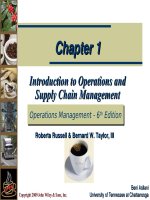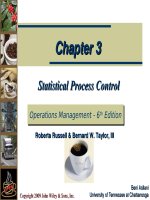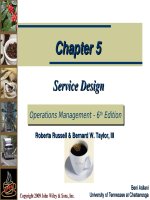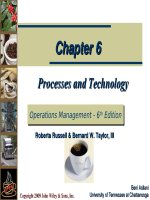Enterprise systems for management 2nd by motiwalla and thompson chapter 10
Bạn đang xem bản rút gọn của tài liệu. Xem và tải ngay bản đầy đủ của tài liệu tại đây (427.75 KB, 46 trang )
CHAPTER 10
GLOBAL, ETHICS,
AND SECURITY
MANAGEMENT
1
Copyright © 2012 Pearson Education, Inc. Publishing as Prentice Hall
Learning Objectives
• Learn about outsourcing, offshore outsourcing
(offshoring), and its business and cultural implications, as
well as the Software as a Service model (SaaS).
• Know the ethical and legal issues related to ERP systems
and implementations and how to protect the company
assets.
• Understand the numerous components to system security
and why security must be planned, tested, and ready by
the time the ERP implementation is at Go-live.
• Understand green computing phenomenon and ERP’s
role in green IT.
• Examine the impact of the Sarbanes–Oxley Act on ERP
implementations.
2
Copyright © 2012 Pearson Education, Inc. Publishing as Prentice Hall
Preview
• In general outsourcing helps organizations to:
– Lower the high software ownership and maintenance costs
– Simplify the traditional difficulties in implementation
– Avoid the problems of hiring and retaining IT staff to run the
applications.
• Companies thinking of outsourcing need to have a
strategy that is appropriate for their organizations.
• Requires proper oversight and a well-defined
relationship with the outsourced partner.
• Security is another major concern, both during and after
the ERP implementation.
3
Copyright © 2012 Pearson Education, Inc. Publishing as Prentice Hall
Outsourcing
• Outsourcing occurs anytime a company decides to
subcontract its business processes or functions to
another company.
• The company (Outsourcer) enters into an outsourcing
arrangement with another firm (Outsourcee) to provide
services under contract for a certain price and period.
• Most IT outsourcing initially occurred in such back-office
functions as technical support, software development,
and maintenance areas.
4
Copyright © 2012 Pearson Education, Inc. Publishing as Prentice Hall
Figure 10-1 Outsourcing Relationship
5
Copyright © 2012 Pearson Education, Inc. Publishing as Prentice Hall
Benefits of Outsourcing
• Economics—A company can solve all of the problems
of running an application at a lower cost.
• Market Agility—Offers faster time to solutions
• Breadth of Skills—Provides an avenue to access
advanced expertise quickly
• Technical Expertise—Enables a company to provide
access to cutting-edge IT solutions to its employees and
clients
• Multiple Feedback Points—Provides an outside or
external perspective during implementation and
maintenance
6
Copyright © 2012 Pearson Education, Inc. Publishing as Prentice Hall
Benefits of Outsourcing (Cont’d)
• Best Practices—Provides access to best practices in
ERP
• Scalability—Allows companies to scale their service
agreements with minimal disruption
• Process-Oriented—Ensures timely delivery of quality
solutions at lower costs
• Solution-centric—Allows companies to work with both
third-party components and custom-developed code to
meet ERP requirements
• Upgrade Crunch—No worries about upgrades
• Fear of Distraction—Allows employees to focus on their
core competencies
7
Copyright © 2012 Pearson Education, Inc. Publishing as Prentice Hall
Drawbacks of Outsourcing
• Lack of Expertise—An external company may not know
or have the expertise to understand the in-house
developed application.
• Misaligned Expectations—Misunderstandings can often
occur between organizations.
• Culture Clash—Different Cultures (Process and
mannerisms of the outsourcing company may be very
different from that of the organization.)
• Hidden Costs—Surprise or unanticipated charges like
travel costs etc.
8
Copyright © 2012 Pearson Education, Inc. Publishing as Prentice Hall
Drawbacks of Outsourcing (Cont’d)
• Loss of Vision - Outsourcing arrangements often result
in a loss of institutional knowledge (e.g., feedback from
clients, problem-solving capability, and new idea
generation).
• Security and Control - Outsourcing requires companies
to share their trade secrets, which can be risky in a
competitive environment. Companies have little control
over employees of outsourcees, especially in global or
high-turnover markets.
9
Copyright © 2012 Pearson Education, Inc. Publishing as Prentice Hall
Offshore Outsourcing
• Off-shoring is when a company selects an outsourcing
partner from another country.
• Offshore partners are often selected from developing
countries to lower the labor costs.
• The latest trends in IT implementations call for offshoring critical developmental tasks to improve quality,
reduce costs, and speed delivery.
• Offshore implementers can face barriers of language,
culture, and values, making the ERP implementation
more challenging.
10
Copyright © 2012 Pearson Education, Inc. Publishing as Prentice Hall
Figure 10-2 Off-Shore Outsourcing
11
Copyright © 2012 Pearson Education, Inc. Publishing as Prentice Hall
Global ERP Vendor Selection
• When evaluating an outsourcing partner, ERP selection
teams should consider financial status, technical
certifications, licenses, qualifications, and related work
experience.
• Companies also need to be prepared if the offshore
experiment is a disaster.
• Culture is one of the biggest challenges facing
companies that offshore their ERP initiatives.
• Factors like: time differences, travel and communication
costs, language and cultural differences could retard offshoring efforts.
12
Copyright © 2012 Pearson Education, Inc. Publishing as Prentice Hall
Software as a Service (SaaS)
• Saas is a model of software that can be rented or leased
from a software vendor who provides maintenance, daily
technical operation, and support for the software.
• Software can be accessed from a browser by any
market segment, including home consumers, and small,
medium, and large businesses.
• The SaaS model brings lower risk in the implementation
cycle and better knowledge transfer from integrators to
users of systems.
13
Copyright © 2012 Pearson Education, Inc. Publishing as Prentice Hall
Benefits of the Saas Model
• Universal Access—Lower learning curve for users
• Ubiquitous Computing—Suitable for cost reduction and
outsourcing
• Standardized Applications—Easy switch between
systems
• Parameterized Applications—Allow customization
• Global Market—A hosted application, however, can
instantly reach the entire market.
• Reliability of Web—Web delivery of software.
• Transparent Security and Trust—Lesser burden of
end-user configurations or VPNs.
14
Copyright © 2012 Pearson Education, Inc. Publishing as Prentice Hall
Limitations of the Saas Model
• Minimal user privacy.
• Limited flexibility allowed to the individual user.
• Significant investment in resources (and possibly thirdparty technology) to configure and support the solution.
• It is quite possible that over a 3 or 5-year period,
traditional ERP architecture might even be cheaper than
an SaaS solution.
15
Copyright © 2012 Pearson Education, Inc. Publishing as Prentice Hall
Types of SaaS Providers
• Application Service Provider (ASP)
– A customer purchases and brings to a hosting company a copy
of software, or the hosting company offers widely available
software for use by customers.
• Software On-Demand (SOD)
– This means that one copy of the software is installed for use by
many companies who access the software from the Internet.
16
Copyright © 2012 Pearson Education, Inc. Publishing as Prentice Hall
Outsourcing Best Practices
• In-sourcing
– ERP managers invite a representative or entire team to work
onsite allowing the project manager to supervise the work
personally to ensure that agreed-upon metrics are met.
• Creation of a formal governance process
– Vendor governance is a critical success factor and must include
global relationships and business process outsourcing with
formal methodologies.
• Plan for installing upgrades
– Maintaining modules, trouble-shooting problems, and policing
platforms once the software enters the longest phase of its life
cycle.
17
Copyright © 2012 Pearson Education, Inc. Publishing as Prentice Hall
Outsourcing Best Practices (Cont’d)
• Accountability
– ERP implementation teams should not consider outsourcing
and off-shoring when they want someone else to take
accountability or to deflect blame in the event something
unfortunate transpires.
• Expediency
– In the event resources are not available, send the work to a
qualified partner and reap the benefits of watching and learning
for the first time.
18
Copyright © 2012 Pearson Education, Inc. Publishing as Prentice Hall
Ethics
• Ethics is a general term for what is often described as the
science of morality.
• In philosophy, ethical behavior is that which is good or
right in a certain value system.
• Two forces endanger privacy in the information age.
– Growth of information technology.
– Increased value of information in decision making.
• There are substantial economic and ethical concerns
surrounding property rights, which revolve around the
special attributes of information itself and the means by
which it is transmitted.
19
Copyright © 2012 Pearson Education, Inc. Publishing as Prentice Hall
Figure 10-3 Ethical Framework
20
Copyright © 2012 Pearson Education, Inc. Publishing as Prentice Hall
Ethical Principles
• Privacy
– The right to control what information needs to be safeguarded
and what can be made available to the public.
– Any organization that collects personal information must follow a
process on how this information is collected, used, and shared.
• Other problems are hacking, snooping, and virus attacks on
the system, which also violate the privacy rights of
individuals.
• Examples of Privacy laws passed in the U.S. are:
– Privacy Act of 1974.
– Children’s Online Privacy Protection Act of 1998.
– e-Privacy Act of 2002.
– Biggest threat to privacy from ERP systems is from data-mining
activities.
21
Copyright © 2012 Pearson Education, Inc. Publishing as Prentice Hall
Ethical Principles (Cont’d)
• Accuracy
– Requires organizations that collect and store data on
consumers to have a responsibility in ensuring the accuracy of
this data.
– Protect an individual or consumer from negligent errors and
prevent intentional manipulation of data by organizations.
– Certain laws require information providers to report under
guidelines.
• They must provide complete and accurate information to the credit
rating agencies.
• The duty to investigate disputed information from consumers falls
on them.
• They must inform consumers about negative information that has
been or is about to be placed on a consumer’s credit report within
30 days.
22
Copyright © 2012 Pearson Education, Inc. Publishing as Prentice Hall
Ethical Principles (Cont’d)
• Property
– Makes organizations realize that they are not the ultimate
owners of the information collected on individuals.
– Consumers give organizations their information on a condition
that they will be guardians of this property and will use it
according to the permission granted to them.
– ERP systems facilitate the process of sharing information easily
by integrating information within the organization and across
organizations.
– If implemented without proper controls, ERP can make it hard to
safeguard information.
23
Copyright © 2012 Pearson Education, Inc. Publishing as Prentice Hall
Ethical Principles (Cont’d)
• Accessibility
– ERP implementation teams must ensure that information
stored in the databases about employees, customers, and
other partners is accessible only to those who have the right to
see and use this information.
– Adequate security and controls must be in place within the
ERP system to prevent unauthorized access.
– Hacking, snooping, and other fraudulent access to data is a
big concern to organizations.
24
Copyright © 2012 Pearson Education, Inc. Publishing as Prentice Hall
Code of Ethics for ERP
• There are three normative theories of ethical behavior
that can be used by organizations to influence the ERP
implementation.
– Stockholder Theory. Protects the interest of the investors or
owners of the company at all costs.
– Stakeholder Theory. Protects the interests of everyone
having a stake in the company success; namely, owners and
stockholders, employees, customers, vendors, and other
partners.
– Social Contract Theory. Includes the right of society and
social well-being before the interest of the stakeholders or
company owners.
25
Copyright © 2012 Pearson Education, Inc. Publishing as Prentice Hall









